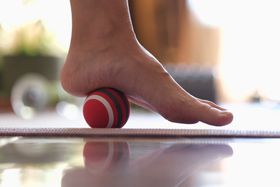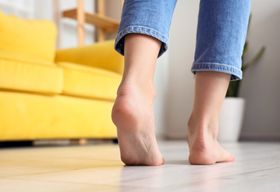5 Calf Stretches for Plantar Fasciitis: Essential Relief Exercises
For anyone suffering from plantar fasciitis, the key to relief lies in addressing tight calf muscles. Simple stretches can significantly reduce pain by improving ankle flexibility and reducing strain on the plantar fascia.
Updated July 16, 2025

Your first steps out of bed shouldn't feel like walking on glass. Yet for the 1 in 10 people who develop plantar fasciitis at some point in their lives, morning heel pain becomes a painful routine [1].
That stabbing heel pain isn't just bad luck. It's your body telling you that the thick band of tissue running across your foot bottom—the plantar fascia—is inflamed. The good news? Simple calf stretches can provide real relief.
Symptoms of Plantar Fasciitis
Plantar fasciitis symptoms follow a predictable pattern, making self-diagnosis straightforward.
Here's what to watch for:
- Sharp heel pain in the morning hits you the moment your feet touch the floor. When you suddenly stretch it with that first step, pain shoots through your heel. Walking around for a few minutes usually helps the tissue warm up and the pain fade.
- Tender heel pressure creates a specific sore spot along the inner edge of your heel. Press your thumb into this area and you'll feel sharp discomfort that can linger long after you stop pressing. The pain often decreases with activity but returns by evening when you stop moving.
- Pain after sitting strikes when you get up from your desk or couch. This happens because your plantar fascia stiffens during rest. The tissue that felt fine while you were sitting suddenly protests when you ask it to work again.
- End-of-day throbbing builds throughout the day as inflammation accumulates. By evening, pain spreads from your heel through your foot's arch. This delayed reaction shows how repeated stress creates ongoing tissue irritation.
The Connection Between Your Calves and Plantar Fasciitis
Your calf muscles might seem unrelated to heel pain, but they're major players in plantar fasciitis development.
When your gastrocnemius and soleus muscles (your two main calf muscles) get tight, they limit your ankle's ability to bend upward. This restriction forces your foot to overpronate—rolling inward too much—during walking.
An overpronated foot puts uneven stress on your plantar fascia, creating tiny tears that lead to inflammation and pain.
Tight calves also prevent your foot from naturally absorbing shock during impact. Instead of the force spreading evenly, it concentrates on your plantar fascia, overloading this tissue with each step. Over time, this repeated stress creates the perfect conditions for plantar fasciitis to develop.
Why You Should Stretch Your Plantar Fascia
Recent research shows that plantar fascia stretching exercises are more effective than oral anti-inflammatory drugs and may work better than general calf stretches alone [2]. The key is consistency rather than intensity.
Studies also demonstrate significant improvements in pain scores and muscle strength when people stick to regular stretching routines [3]. You'll also improve muscle function and coordination.
5 Best Calf Stretches for Plantar Fasciitis
1. Wall Calf Stretch
- Best for: Beginners and people who spend most of their day sitting. Works well for early-stage inflammation and mild symptoms. Perfect for morning routines to warm up tight muscles.
- What to Expect: Three sessions per week, holding for 30-60 seconds with 3-10 repetitions, will improve muscle flexibility within a few weeks. You'll notice reduced morning stiffness and better ankle movement during daily activities.
This classic stretch targets your gastrocnemius—the large, surface calf muscle responsible for pointing your foot downward. When this muscle shortens from tightness, it pulls on your entire lower leg chain.
How to Do it:
- Place your hands against a wall, step your affected leg back about three feet, and keep that heel planted on the ground.
- Lean forward until you feel a strong stretch in your back calf. The key is keeping your back leg completely straight to isolate the gastrocnemius.
2. Seated Towel Stretch
- Best for: Beginners, elderly individuals, and anyone who can't stand for long periods due to pain. Perfect for moderate to severe symptoms. Use it first thing in the morning before getting out of bed, or at bedtime to reduce daily tension.
- What to Expect: Daily practice (30-60 second holds) improves both plantar fascia and Achilles tendon flexibility. This reduces ankle stiffness and foot pain while improving overall function.
The non-weight-bearing position makes this stretch accessible when standing hurts too much. You can control the intensity by adjusting how hard you pull on the towel.
How to Do it:
- Sit on the floor with legs extended.
- Loop a towel around the ball of your foot and gently pull your toes toward you. This stretch works both calf muscles simultaneously while taking weight off your feet.
3. Heel Drop Stretch
- Best for: Athletes and active people with sufficient calf strength and balance. Works well for mild to moderate plantar fasciitis symptoms in people who can handle weight-bearing activities.
- What to Expect: Regular practice provides combined strength and flexibility benefits. It improves ankle control, body awareness, and helps realign foot and ankle mechanics. The dual benefit makes this especially valuable for preventing future problems.
The stretch combines flexibility and strength training, making it particularly effective for athletic individuals who need both mobility and power.
How to Do it:
- Stand on the edge of a step with your affected foot's heel hanging off.
- Lower your heel below the step level, creating an intense stretch through your entire calf and Achilles tendon. This eccentric loading helps elongate tight muscles while building strength.
4. Downward Dog Stretch
- Best for: Yoga practitioners, advanced exercisers, and athletes. Best performed at the end of the day rather than first thing in the morning, as it can be energizing.
- What to Expect: Regular practice improves overall body awareness while specifically lengthening calf muscles. It enhances proprioception (body position sense) and helps train better foot mechanics. You'll also notice improved overall posture and flexibility.
The full-body nature of this stretch makes it particularly effective but also more demanding than isolated stretches.
How to Do it:
- Start on hands and knees, then lift your hips up and back, forming an inverted V shape.
- Press your heels toward the ground to intensify the calf stretch. This yoga pose stretches your entire posterior chain—calves, hamstrings, and plantar fascia—in one movement.
5. Runner's Lunge Stretch
- Best for: Runners and people involved in regular physical activity. Works well as both a warm-up and a cool-down. Suitable for mild to moderate symptoms where weight-bearing isn't problematic.
- What to Expect: This stretch excels at reducing post-activity pain flare-ups. It minimizes the impact of prolonged standing or walking and, when done before daily activities, reduces stress on your ankle and foot throughout the day.
The position stretches your plantar fascia along its full length while also working your Achilles tendon and calf muscles. It's particularly effective because it mimics positions used during walking and running.
How to Do it:
- Step your affected leg back into a lunge position, keeping your back heel down and leg straight. This dynamic stretch targets calf muscles while providing stability training for your ankle and foot complex.
Beyond Stretching: Building Long-Term Success
Calf stretches work best as part of a complete approach to plantar fasciitis management.
Proper Footwear
Proper footwear makes a significant difference. Shoes with built-in arch support, deep heel cups, and shock-absorbing insoles reduce plantar fascia strain. Hard-soled shoes force your plantar fascia to work harder as a shock absorber, contributing to overuse and inflammation.
Weight Management
Weight management reduces the load on your feet with every step. With plantar fasciitis affecting approximately 10% of the US population, addressing modifiable risk factors like excess weight can prevent problems before they start [4].
Custom Orthotics
Custom orthotic inserts like those from Upstep redistribute pressure evenly across your foot while supporting your arch to prevent excessive pronation. Quality insoles minimize arch strain and help prevent the ankle movement restrictions that cause calf tightness in the first place.
Breaking Free from Morning Heel Pain
Calf stretches offer genuine relief for plantar fasciitis because they address the root mechanical problem. The six stretches outlined here target both major calf muscles through different positions and intensities. Wall stretches work for beginners dealing with morning stiffness.
Towel stretches help when weight-bearing hurts too much. Advanced options like heel drops and downward dog provide combined strength and flexibility benefits for active individuals.
Success requires consistency over intensity. Three weekly sessions with proper form will deliver better results than daily aggressive stretching that inflames tissues. Combined with supportive footwear and orthotics, these stretches can transform painful mornings into pain-free starts to your day.
References:
- T. Trojian and A. K. Tucker, “Plantar fasciitis,” AAFP, Jun. 15, 2019. Available: https://www.aafp.org/pubs/afp/issues/2019/0615/p744.html
- R. Gupta et al., “Comparing the role of different treatment modalities for plantar fasciitis: a double blind randomized controlled trial,” Indian Journal of Orthopaedics, vol. 54, no. 1, pp. 31–37, Jan. 2020, doi: 10.1007/s43465-019-00038-w. Available: https://pubmed.ncbi.nlm.nih.gov/32257015/
- F. Arntz et al., “Chronic Effects of Static Stretching Exercises on Muscle Strength and Power in Healthy Individuals Across the Lifespan: A Systematic Review with Multi-level Meta-analysis,” Sports Medicine, vol. 53, no. 3, pp. 723–745, Jan. 2023, doi: 10.1007/s40279-022-01806-9. Available: https://pmc.ncbi.nlm.nih.gov/articles/PMC9935669/
- B. K. Buchanan, R. E. Sina, and D. Kushner, “Plantar fasciitis,” StatPearls - NCBI Bookshelf, Jan. 07, 2024. Available: https://www.ncbi.nlm.nih.gov/books/NBK431073/
Disclaimer: The information on this blog is for educational purposes only and is not a substitute for professional medical advice. Upstep does not provide medical diagnosis or treatment. While qualified podiatrists create our content, it's essential to consult with your healthcare provider for any foot or ankle concerns you may have.
FAQS
Does foam rolling my calves help relieve plantar fasciitis?
Foam rolling your calves can definitely help relieve plantar fasciitis. Tight calves increase strain on your Achilles tendon and plantar fascia. By using a foam roller, you can loosen those tight calf muscles, reducing tension and ultimately helping to ease your heel pain.
Can too much stretching aggravate plantar fasciitis?
Yes, absolutely. Too much stretching can aggravate plantar fasciitis. If the tissue is already inflamed or damaged, overdoing stretches can cause further micro-tears and prevent proper healing, ultimately increasing your pain. Consistency and gentle movements are key, not aggressive intensity.
Do calf compression sleeves help plantar fasciitis?
Yes, calf compression sleeves can help with plantar fasciitis by improving circulation and reducing swelling in your lower leg and foot. They also offer gentle support to your calf muscles, which can reduce strain on the plantar fascia. Think of them as a helpful addition to your overall treatment plan, not a sole solution.
Will rolling a ball under my foot help plantar fasciitis?
Absolutely, rolling a ball under your foot is excellent for plantar fasciitis. This self-massage technique releases tightness in the plantar fascia and foot muscles, boosts circulation, and helps reduce pain and stiffness. It's a simple, effective way to get relief.
How can I tell if my plantar fasciitis is healing?
You'll know your plantar fasciitis is healing when you experience less morning heel pain, reduced stiffness, and an easier time walking or standing. Essentially, consistent improvement in your pain levels and daily function indicates recovery.














